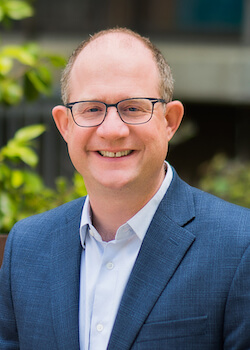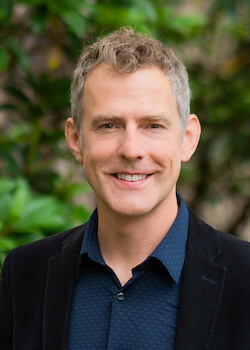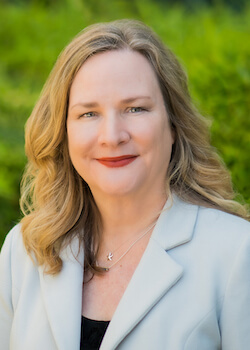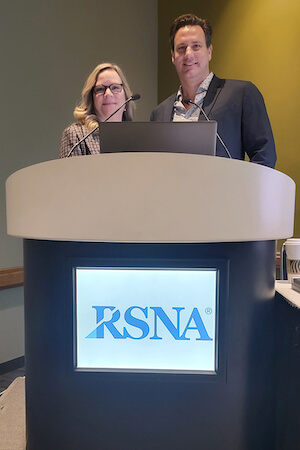MRI Safety Practices: "Every Minute, Every Day"
UCSF Radiology & Biomedical Imaging strives to ensure patient safety in all our imaging modalities, and this includes providing patients with the highest level of MR safety. MR Safety is overseen by the MR Safety Committee, led by Michael Ohliger, MD, PhD, associate professor and MR Modality Director. Additional leaders contributing to our MR Safety focus are Michael Hoff, PhD, associate professor and MRI Safety Expert (MRSE) and Christina Calvin, MRI Safety Officer (MRSO) and Supervisor.
The charge of the MR Safety committee is to establish, maintain and routinely review UCSF MRI Safety policies and procedures for both clinical and research imaging; to maintain national and international MR standards; and to provide a formal review process for significant changes to the hardware or software of our MRI systems.
 "The MR Safety Committee has a presence at all levels," says Dr. Ohliger. "We administer all MR Safety protocols at UCSF. In addition to Radiology's scanners, the Committee establishes safety protocols for the MR scanners in Radiation Oncology, Neurology and Neuroscience. The Committee also serves as a resource, providing MR Safety information through trainings, the department's MR Safety webpages, publications and outreach to the broader radiological community."
"The MR Safety Committee has a presence at all levels," says Dr. Ohliger. "We administer all MR Safety protocols at UCSF. In addition to Radiology's scanners, the Committee establishes safety protocols for the MR scanners in Radiation Oncology, Neurology and Neuroscience. The Committee also serves as a resource, providing MR Safety information through trainings, the department's MR Safety webpages, publications and outreach to the broader radiological community."
Dr. Ohliger says that MR safety requires a system of constant vigilance. "We screen patients for metallic implants and objects at every point of contact on their journey as a patient," says Dr. Ohliger. "We have a rigorous vetting process organized by Christina Calvin and Dr. Michael Hoff that includes documenting hardware and implants to decrease the likelihood of something slipping through into the MR environment." He notes that this can be a challenge because of the quantity and variety of implanted medical devices in use today. According to Dr. Ohliger, attention to detail, such as carefully following protocols, is key to maintaining a safe MR environment: "What you are preventing through attention to detail is the possibility of larger safety incidents." In situations where there is a concern or an incident, the MR Safety Committee provides both follow up and process improvement to ensure that it is not repeated.
 There is a proactive and a reactive element to safety, according to Dr. Hoff. "We carefully set up imaging protocols while considering national and international standards. We also analyze imaging outcomes as a group and adjust our procedures and protocols as needed to ensure that we maximize future imaging efficiency and safety. When you subjecting patients to powerful and complex magnetic fields, you need comprehensive oversight over all patients and personnel in that environment, and that oversight is provided by the MR Safety Committee."
There is a proactive and a reactive element to safety, according to Dr. Hoff. "We carefully set up imaging protocols while considering national and international standards. We also analyze imaging outcomes as a group and adjust our procedures and protocols as needed to ensure that we maximize future imaging efficiency and safety. When you subjecting patients to powerful and complex magnetic fields, you need comprehensive oversight over all patients and personnel in that environment, and that oversight is provided by the MR Safety Committee."
Education is extremely important to MR Safety, according to Calvin, who does an MRI safety class with all new hires, including nurses (LVNs), patient navigators and MRI technologists: "They spend time with me during their first two weeks to review the procedures and expectations for MRI safety." In addition, formal quarterly meetings are held for all staff that work in the MR arena. The two-hour meetings feature guest speakers, discussion and information about new procedures. Drs. Ohliger and Hoff are included on the schedule, and Calvin does a regular safety presentation. Calvin recently instigated a new education initiative in partnership with UCSF Occupational Health that facilitates MR Safety training offerings through their learning portal.
 UCSF Health Hospitality staff also receive important MR Safety training geared to their job duties. "We are implementing an MR-safe hospitality cart and special cleaning procedures for Zone 4, the magnet room, which has high magnetic fields," says Calvin. "We just completed a training with 60 hospital staff to ensure that they understand safe practices in the MRI zone." Calvin has also created an MR Safety Alert email to communicate with frontline staff, including those at ZSFG. The alert advises on national and international MR safety incidents, UCSF MR updates and best practices.
UCSF Health Hospitality staff also receive important MR Safety training geared to their job duties. "We are implementing an MR-safe hospitality cart and special cleaning procedures for Zone 4, the magnet room, which has high magnetic fields," says Calvin. "We just completed a training with 60 hospital staff to ensure that they understand safe practices in the MRI zone." Calvin has also created an MR Safety Alert email to communicate with frontline staff, including those at ZSFG. The alert advises on national and international MR safety incidents, UCSF MR updates and best practices.
According to Calvin, a challenge is cross-departmental education. "We spend 80% of our time in the MR environment, and MR safety is part of our department's clinical training whereas many RNs and some physicians spend most of their time outside the MR environment. It is not always built into their practice that MR Safety is at the forefront." Calvin works extensively to provide education and share knowledge with multi-departmental teams, including the surgical operating room, where the Committee recently developed new workflow for interoperative MRI. Calvin also attends Radiation Oncology's monthly meetings to provide MR Safety guidance for staff treating patients with cancer.
Calvin and Craig DeVincent, RT, a Radiology MRI Manager, gave a presentation on MR Safety at RSNA in December, bringing our department's MR knowledge and best practices to a large audience. "This type of outreach is an extension of the MR Safety committee," says Dr. Ohliger. "It is important that we share our expertise with the broader community".
"When you think of new technologies that are coming to MRI, remote scanning is at the forefront," says Dr. Hoff. "American College of Radiology (ACR) guidance has stipulated that remote scanning should only be used in situations where specialized personnel are unable to be present for scanning, as opposed to as a cost-savings measure to reduce staff. Our MRI Safety Committee will reinforce that theme by utilizing the latest technologies and techniques to provide optimal patient care, while still maintaining the highest level of patient safety."
"I want to highlight that technologists are the bedrock of patient MRI safety," says Dr. Ohliger. "Eventually MRI scanners may operate more automatically but what will never be replaced is the ability to image safely and make sure the patient is getting the correct experience. Trained technologists are highly aware, with extraordinary skill and knowledge. We are lucky that we have excellent technologists who can bring patients safely through the system."
"MRI safety really starts with the person who is looking in the mirror every morning," says Calvin. "The following is a mantra that I keep close to my heart: "This is our workplace, our work environment, our patients, our co-workers and our MRI Safety responsibility."
